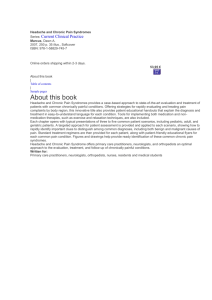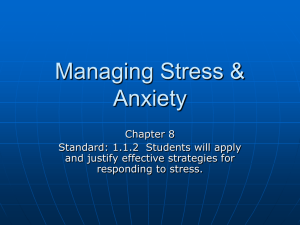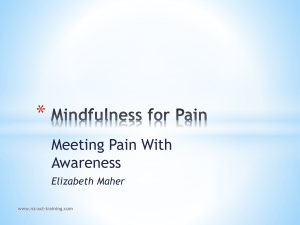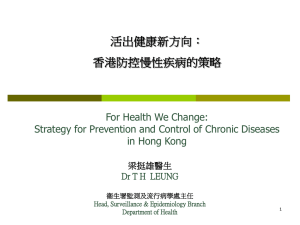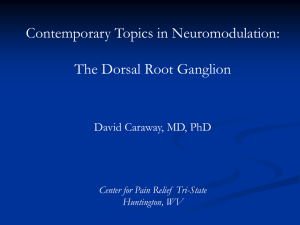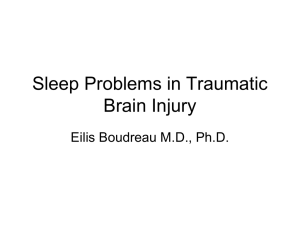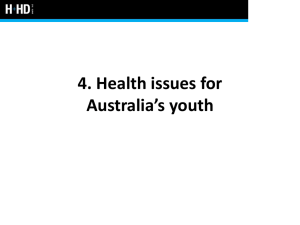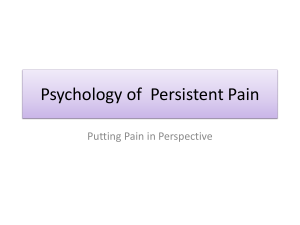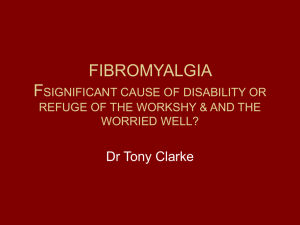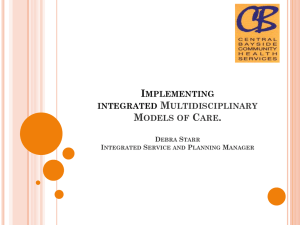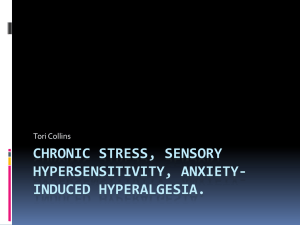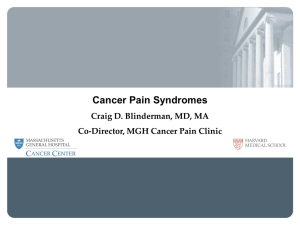Out of the Nurses Office and Back to the Classroom: A Functional
advertisement
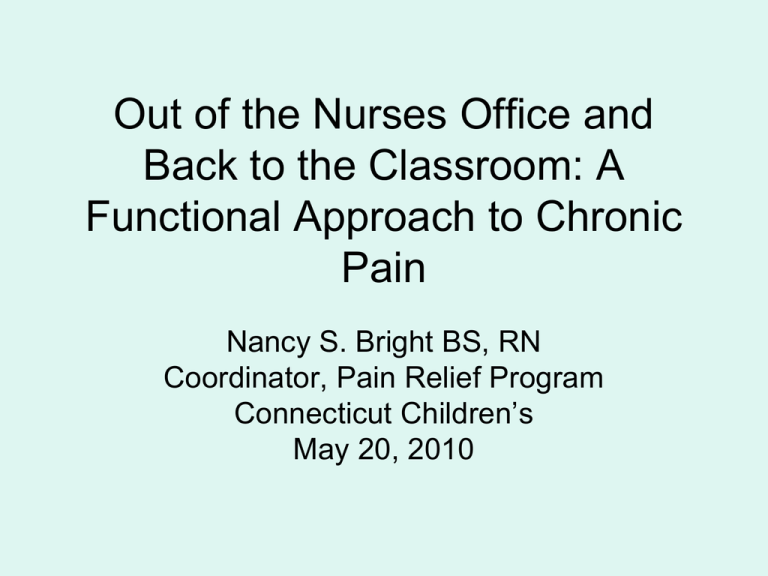
Out of the Nurses Office and Back to the Classroom: A Functional Approach to Chronic Pain Nancy S. Bright BS, RN Coordinator, Pain Relief Program Connecticut Children’s May 20, 2010 Objectives • To understand the multifactorial components of chronic pain • To learn about a functional approach to treating chronic pain • To identify challenges for integrating children with chronic pain back into the school setting Body maps Sources of Chronic Pain • Ongoing illness: sickle cell, cancer • Post infectious myalgias that sensitize the central nervous system • Non-progressive disorders whose manifestation is pain—chronic daily headache, functional abdominal pain, widespread musculoskeletal pain Functional Pain Syndromes • A disorder that after appropriate medical assessment cannot be explained in terms of conventionally defined medical disease based on biochemical or structural abnormalities • Not typically responsive to conventional medical therapy but responsible for the consumption of enormous medical resources • Unfortunately, often pejorative implication, i.e. pain is not organic and therefore not real or serious • As a result, patients often marginalized from meaningful professional care A new model • Traditionally, all of these entities were viewed in the medical model • Assumption was that if pain did not have an identifiable biologic etiology, it was psychological in origin Central sensitization • Overall, increased sensitivity to pain both peripherally and centrally • Hypersensitivity of the peripheral nerves • Explanatory model of hurt versus harm Chronic pain • Recognition that the experience of pain is the result of the interplay of biologic predispositions (genetic tendencies, pain vulnerabilities) and a host of psychosocial factors that either amplify or diminish the pain Epidemiology • • • • Marked increase in pain prevalence at 8 years Incidence peaks at 14 years Transition years in school: 5th, 7th, 9th grade Over 50% of children who reported chronic pain reported pain in multiple sites • Incidence of multiple pain sites increased with age • Girls 2X as likely to have multiple sites of chronic pain • HA and abdominal pain most common combination (25% of all cases of multiple pain sites) Incidence musculoskeletal pain – Overall prevalence – 22% • • • • Fibromyalgia – 1.25% (7% of pedi rheum referrals) Knee pain – 18% Back pain – 7-34% Limb pain – 4-33% – Pain persistence - 31% had pain 1 year later and 30% had recurrences of pain 4 years later Incidence headache • Overall headache incidence over childhood 37% – Migraine occurrence: 5-15 yrs - 10.6% 10-19 yrs – 28% – Tension – 18.5% – Unclassifiable – 74% • 22% of neurology referrals for headache Incidence abdominal pain • 2-4% of pediatric visits • 50% of GI consultations • 21% reported pain severe enough to affect activities Pain related visits to school nurse • In a large, urban school district in Milwaukee, WI the most common reason for visit to the school nurse, other than first aid: – Stomach ache 17% – Headache 16% 59% females » Hainsworth et al, Children’s hospital of WI 2009 Impact on the Child • 30-40% restrictions in daily living • 90% decreased or no sporting activities • Increased social difficulties – 68% of large study of chronic pain pts had significant restrictions on daily life • Sleep – 50% 0f children with chronic pain have sleep difficulties – Sleep initiation – Maintaining sleep – Early morning awakening • Chronic pain has potential to permanently alter child’s development and future role functioning Impact on School • Academic –Often academic deterioration –Frequent school absence –1 in 6 patients with chronic pain had missed one third of school year –Impaired ability to cope with the demands of classroom/homework workload Teachers • Teacher response to chronic pain may influence the extent to which school functioning is disrupted in children with pain – Over solicitous – Not understanding – Parents approach to school may affect the schools response to accommodations » Logan et al, 2007 Impact on Family • Frustration of finding the diagnosis and understanding it • Loss time from work • Flexibility in orchestrating a return to school; negotiating make up work • Fitting in appointments such as physical therapy, psychology in addition to the activities of other siblings Psychiatric co morbidity • Study of 3500 schoolchildren, stress and depressive symptoms associated with chronic pain • Prospective study of 9000 pain free individuals – depressed individuals were 3x more likely to develop new onset chronic back pain than non depressed • In sample of 80 adolescents with chronic pain (Eccleston, Pain 2004), anxiety scores 2x as large as general population; depression in 70% of sample • Increased catastrophizing and lower self esteem Psychiatric co morbidity Abdominal pain – More anxiety and depression – In one study 79% of children referred for recurrent abdominal pain meet criteria for anxiety disorder; 43% depressive disorder Headache – Psych co-morbidity in children, 46% of chronic daily headache vs. 17% migraine; anxiety disorders predict headache persistence and poorer treatment response – 86% of children with Chronic daily headache reported severe school achievement related stress – WMSP (fibromyalgia) – Children with fibromyalgia more likely to be depressed Commonalities of chronic pain problems • Female predominance • Abnormalities of pain processing • Frequent psychiatric comorbidity/stress sensitivity • Similarities of diagnostic approach and treatment Treatment plan • Demystify the problem – hurt vs. harm; labels such as psychosomatic are not helpful and in fact not accurate • Emphasize the fact that pain no longer has a warning function • State clearly that symptom complex is familiar to the provider; symptoms are real and not imagined • Reassurance is critical as many families will have had frustrating experience with medical community and often misdiagnosis or no diagnosis • Goal of treatment should be return to function; not solely reduction of pain Treatment plan • Medications for pain: neuropathic, preventive • Recognize role of anxiety, depression • Psychological support/ health psychologist • Treat sleep problems • Establish regular exercise or physical therapy program • Biofeedback, acupuncture, massage Go to School • School – Development of modification plan /504 plan • Frequency of Attendance • Graduated return to school- scripted reentry plan • Nurse office sanctuary • Criteria for staying home- fever>102 • Work modification • Tutoring support for missed work Return to school • An integral part of clinical care • School attendance is how we measure function, which is a more accurate measure of pain than a pain scale • School performance indicates adaptive response to pain Summary • Chronic pain problems have biological, psychological and social components • Treatment plan needs to be multidisciplinary • Return to school is an important part of the clinical care plan References • • • • • • • • Logan D, Scharff L et al. Evaluating Teacher’s Perceptions to Children with Chronic Pain Syndromes. Children’s Hospital, Boston Ladwig J, Khan K. School Avoidance: Implications for School Nurses. JSPN Vol 12, No 3, July 2007. pp 210-212. Logan D, Coakley R, Scharff L. Teachers’ Perceptions of and Responses to adolescents with Chronic Pain Syndromes. Journal of Pediatric Psychology 2007 vol32 no 2, pp 139-149. Mayer EA, Bushnell MC. Functional Pain Syndromes. Seattle: IASP Press, 2009. Williams DA, Clauw DJ. Understanding fibromyalgia: Lessons from the Broader Pain research Community. Journal of Pain 2009:10 pp777-791 Nurko S, DiLorenzo C. Functional Abdominal Pain: Time to Get together and move Forward. Journal of Pediatric Gastroenterology and Nutrition. 2008: 47,pp 679 Scher AI, Stewart WF, Lipton RB. Co morbidity of Headache with Other Pain Syndromes. Headache 2006:46,pp 1416-23 Zeltzer L. Conquering Your Child’s Chronic Pain
